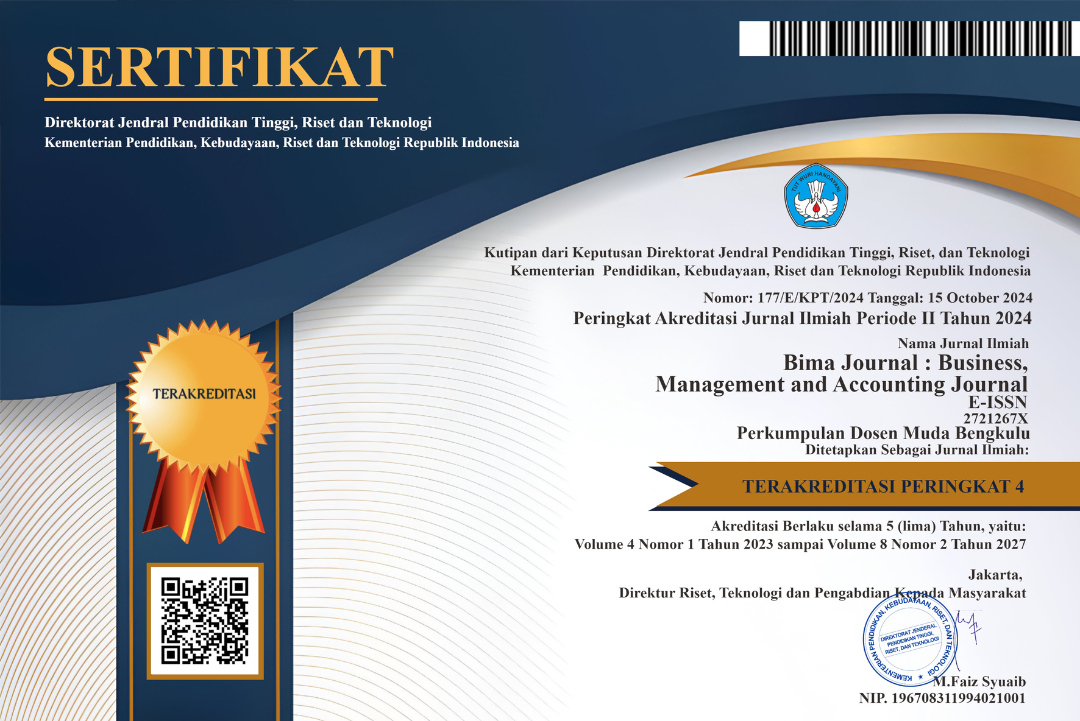The Influence Of Leadership And Reward Style On Employee Performance (Case Study: DPRD Offices Seluma District)
DOI:
https://doi.org/10.37638/bima.2.1.13-22Keywords:
Gaya kepemimpinan, reward, Kinerja pegawaiAbstract
Human resources are an important factor in globalization to face competition among organizations. Leadership style can be defined as an individual ability to be able to organize, direct, motivate employees to be able to help run an organization. The quality of a leader can be recognized if he can influence, direct and improve employee performance in carrying out all assigned tasks. Rewards will usually be given to employees who have contributed to advancing the company in accordance with the standards set by management. The sample used in this research is 34 employees who have become Civil Servants at the DPRD Office of Seluma Regency. Data collection using a questionnaire and the method of analysis used is multiple regression. Before the regression test was carried out, the validity and readability test would be carried out on the data used in the study. From the hypothesis testing, it is found that the leadership style variable (X1) and the reward variable (X2) have a partially significant relationship to employee performance (Y). The amount of the determinant coefficient is 0.590, which means that the independent variables X1 and X2 will be able to influence the dependent variable Y by 59% while the remaining 41% is influenced by other variables outside of this study. While simultaneously the variables X1 and X2 have a simultaneous effect on variable Y
References
Akhmad, S. F. (2015). Pengaruh Kompensasi Dan Lingkungan Kerja Terhadap Kinerja Karyawan (Studi pada Karyawan Bagian Produksi PT. JAMU JAGO Kota Semarang). In E-Jurnal Manajemen Universitas Udayana.
Damarsiwi, E. P. M., & Nasution, S. (2020). Pengaruh Profesionalisme, Independensi Auditor, Etika Profesional, Dan Gaya Kepemimpinan Terhadap Kinerja Auditor. EKOMBIS REVIEW: Jurnal Ilmiah Ekonomi Dan Bisnis, 8(2), 171–182. https://doi.org/10.37676/ekombis.v8i2.1083
Febrianti, S. (2014). PENGARUH REWARD DAN PUNISHMENT TERHADAP MOTIVASI KERJA SERTA DAMPAKNYA TERHADAP KINERJA (Studi pada Karyawan PT. Panin Bank Tbk. Area Mikro Jombang). Jurnal Administrasi Bisnis S1 Universitas Brawijaya, 12(1), 83041.
Ghozali, I. (2015). Aplikasi Analisis Multivariate dengan Program IBM SPSS 23. Badan Penerbit Universitas Diponegoro.
Hasibuan, M. (2016). Manajemen Sumber Daya Manusia (cetakan ke). Bumi Aksara.
Koencoro, G., Musadieq, M., & Susilo, H. (2013). Pengaruh Reward dan Punishment terhadap Kinerja (Survei pada Karyawan PT INKA (Persero) Madiun. Jurnal Administrasi Bisnis, 5(2), 1–8.
Lina, D. (2014). Analisis Pengaruh Kepemimpinan Dan Budaya Organisasi Terhadap Kinerja Pegawai Dengan Sistem Reward Sebagai Variabel Moderating. Jurnal Riset Akuntansi Dan Bisnis, 14, 77–97.
Mangkunegara, A. P. (2015). Manajemen Sumber Daya Manusia Perusahaan (S. Sandiasih (ed.)). Remaja Rosdakarya.
Mansun, M. (2006). Pengukuran Kinerja Sektor Publik (Pertama). BPFE.
Prayogik, I. (2019). Pengaruh budaya organisasi terhadap kinerja pegawai melalui kepuasan kerja pada pdam delta tirta kabupaten sidoarjo.
Purwati, Y., & Nugraha, J. T. (2018). Pengaruh Gaya Kepemimpinan dan Motivasi Kerja terhadap Kinerja Pegawai (Studi Pada Kantor Kelurahan Kedungsari , Magelang Utara). Jurnal Mahasiswa Administrasi Negara, 02(01), 84–95.
Risambessy, A., Swasto, B., Thoyib, A., & Astuti, E. S. (2012). The Influence of Transformational Leadership Style, Motivation, Burnout towards Job Satisfaction and Employee Performance. J. Basic. Appl. Sci. Res, 2(9), 8833–8842. www.textroad.com
Siagian, S. (2020). Manajemen Sumber Daya Manusia. Bumi Aksara.
Sugiyono. (2014). Metode Penelitian Pendidikan Pendekatan Kuantitatif, Kualitatif, dan R&D. Alfabetha.
Tawai, A. (2017). Pengaruh pemberian reward dan disiplin terhadap kinerja pegawai badan pemberdayaan masyarakat dan pemerintahan desa (BPMPD) provinsi Sulawesi tenggara. Kebijakan Dan Pelayanan Publik, 3(3), 1–23.
Wibowo. (2013). Perilaku Dalam Organisasi. PT. Raja Grafindo Persada.
Downloads
Published
Issue
Section
License
An author who publishes in the BIMA JOURNAL: Business, Management, and Accounting Journal agrees to the following terms:
Author retains the copyright and grants the journal the right of first publication of the work simultaneously licensed under the Creative Commons Attribution-ShareAlike 4.0 License that allows others to share the work with an acknowledgement of the work's authorship and initial publication in this journal
Submission of a manuscript implies that the submitted work has not been published before (except as part of a thesis or report, or abstract); that it is not under consideration for publication elsewhere; that its publication has been approved by all co-authors. If and when the manuscript is accepted for publication, the author(s) still hold the copyright and retain publishing rights without restrictions. For the new invention, authors are suggested to manage its patent before published. The license type is CC-BY-SA 4.0.
BIMA JOURNAL: Business, Management and Accounting is licensed under a Creative Commons Attribution-ShareAlike 4.0 International License.
You are free to:
Share — copy and redistribute the material in any medium or format
Adapt — remix, transform, and build upon the material
for any purpose, even commercially.
The licensor cannot revoke these freedoms as long as you follow the license terms.
Under the following terms:
Attribution — You must give appropriate credit, provide a link to the license, and indicate if changes were made. You may do so in any reasonable manner, but not in any way that suggests the licensor endorses you or your use.
ShareAlike — If you remix, transform, or build upon the material, you must distribute your contributions under the same license as the original.
- No additional restrictions — You may not apply legal terms or technological measures that legally restrict others from doing anything the license permits.
Notices:
- You do not have to comply with the license for elements of the material in the public domain or where your use is permitted by an applicable exception or limitation.
- No warranties are given. The license may not give you all of the permissions necessary for your intended use. For example, other rights such as publicity, privacy, or moral rights may limit how you use the material.





















